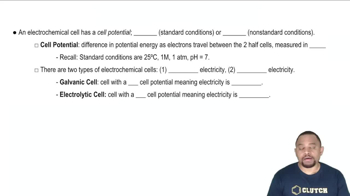Here are the essential concepts you must grasp in order to answer the question correctly.
Nernst Equation
The Nernst Equation relates the reduction potential of an electrochemical cell to the concentrations of the reactants and products. It is expressed as E = E° - (RT/nF) ln(Q), where E is the cell potential, E° is the standard potential, R is the gas constant, T is the temperature in Kelvin, n is the number of moles of electrons transferred, F is Faraday's constant, and Q is the reaction quotient. This equation is essential for calculating the potential of the half-cell under non-standard conditions.
Recommended video:
pH and its Effect on Electrochemical Reactions
pH is a measure of the hydrogen ion concentration in a solution, which can significantly influence the behavior of electrochemical reactions. In this case, a pH of 10.24 indicates a basic environment, affecting the solubility and speciation of manganese ions. Understanding how pH alters the equilibrium of the MnO2/Mn2+ system is crucial for determining the necessary concentration of Mn2+ to achieve the desired potential.
Recommended video:
Cell Potential and Spontaneity
Equilibrium and Reaction Quotient (Q)
The reaction quotient (Q) is a measure of the relative concentrations of products and reactants at any point in a reaction. For the MnO2/Mn2+ half-cell, Q can be expressed as [Mn2+]/[MnO2]. At equilibrium, Q equals the equilibrium constant (K), and changes in concentration will shift the equilibrium position according to Le Chatelier's principle. This concept is vital for understanding how to manipulate [Mn2+] to achieve a specific cell potential.
Recommended video:




